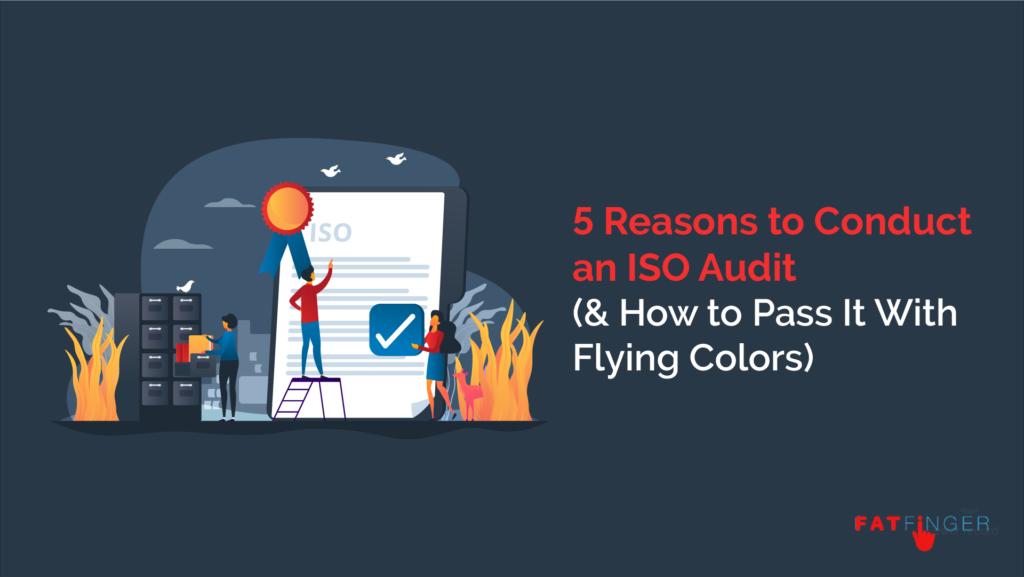
I once bought a new TV from an electrical manufacturer that I’d never heard of before.
It was a great deal, they promised me delivery within five working days, and I only saw positive, glowing reviews from their customers.
So, I thought: Why not. What’s not to like?
Sadly, there was plenty not to like when my new TV arrived.
It came with no set-up instructions, no remote control, and no warranty. And, when I finally got it to work (thanks Google), the picture was pixelated and I couldn’t turn the captions off, because I didn’t have a blasted remote!
The lesson I learned here?
“When things don’t work as they should, it often means that standards are absent.”
ISO, Standards
I won’t be fooled by glowing reviews, too-good-to-be-true prices, and unbeatable service again. Instead, I will only purchase from companies that can show me that they follow and adhere to a set of universal standards that prove they can deliver what they say they can.
From now on, I will only buy from ISO-certified sellers.
And I’m not the only one who feels that way. Research shows that:
“ISO certification is a key factor that could enhance a product’s perceived quality and further influence brand image as well as a consumer’s positive attitude, brand preference, and purchase intention.”
ResearchGate, The Impact of ISO Certification on Consumers’ Purchase Intention
So, as a business, proving you’re ‘up to ISO standard’ and therefore capable of fulfilling your customer’s needs plays a crucial part in your customer’s decision to choose you, over your competitors.
But, to become ISO certified, you need to go through an ISO audit process… which, coincidentally, is what this FAT FINGER post is all about:
- What is an ISO audit?
- 5 reasons to conduct an ISO audit
- What’s involved in an ISO audit?
- How do you pass an ISO audit?
Conducting an ISO audit and gaining ISO certification to prove you’re a credible company that’s able to satisfy your customers is only one-fifth of the story.
Join me for the rest of it…
What is an ISO audit?

In simple terms, an ISO audit is a measurement of how your organization is performing against a set of standards that have been established by the International Organization for Standardization (ISO).
“[An ISO audit] enables the company or organization to check how far their achievements meet their objectives and show conformity to the standards.”
ISO, Management System Standards
The ISO is an independent, international standard-setting body that was formed in 1947. 165 national standards experts, from various industries and countries, share knowledge and develop consensus-based standards to:
- Regulate manufacturing practices
- Control quality
- Provide solutions to global challenges (eg. Information security, or environmental management)
An ISO audit shows the ISO that you are doing what you say you are doing. It proves that your organization complies with the standards set by the ISO and is therefore worthy of an ISO certification. An ISO certification is a proof point that shows your customers that you are who you say you are, you can do what you say you can do, and you are a contender worth considering.
What types of ISO certification can you get?

ISO has published over 21,583 standards, and some of the most common ones include:
- ISO 9001: Quality Management
- ISO 14001: Environmental Management
- ISO / IEC 27000: Information Security Management Systems
- ISO 31000: 2018: Risk Management
- ISO 50001: 2018: Energy Management
- ISO 26000: 2010: Social Responsibility
- ISO 28000: 2007: Specifications for Security Management Systems for the Supply Chain
- ISO 45001: Occupational Health and Safety
But, this isn’t a post about ISO certification or ISO standards, per se. These are topics for another time.
This post is about the ISO audit. So, let’s talk about the benefits of conducting one (aside from receiving ISO certification if you pass).
5 reasons to conduct an ISO audit
In the past two years, there’s been a 50% growth in organizations seeking to become ISO certified. This suggests that there’s a widespread belief in the benefits of ISO certification.
But what are those benefits?
Benefit #1: An ISO audit can identify risks & opportunities 🔍
An ISO audit forces you to look, in forensic detail, at your business processes, systems, people, and procedures to make sure they’re conforming to the set of ISO standards you’re following.
This in-depth look into the nuts and bolts of your organization not only enables you to spot potential problems and actual points of failure, but it also allows you to identify opportunities for improvement and areas for growth.
This whole process will inevitably lead to better decision making, improved performance, more efficient operations, more effective planning, and healthier relationships with customers, staff, and suppliers.
Benefit #2: An ISO audit can stop problems from reoccurring ✋
In most cases, to pass an ISO audit you’ll need to provide ISO auditors with detailed records of all the problems you’ve encountered within your business and how you’ve resolved them.
To do this, you’ll need to maintain careful accounts which detail every problem you’ve had, what the root cause of that problem was, and what long-lasting solution you’ve put in place to stop it from happening again.
This approach will lead to less waste, better quality, and lower costs.
Benefit #3: An ISO audit will boost marketing & sales efforts 🔊
A recent study found that, over the course of four years, firms that were ISO-certified enjoyed a 65% increase in sales compared to firms that weren’t. Non-certified companies only saw a 46% increase in sales.
So, why is that?
“Having an annual ISO audit gives our clients the reassurance that our high standards are continuously maintained”
Richard Johnson, Program Manager, Rock Power Connections
Passing an ISO audit and therefore achieving ISO certification tells potential customers that your products and organization have been independently verified by the highest standards-body in the world. It proves that you’re a safe bet, and so choosing your company over one that hasn’t complied with ISO standards quickly becomes a no-brainer.
“[ISO certification} gives merit to companies, and protects consumers by ensuring that international safety, reliability, and quality standards are met.”
Safety Culture, ISO 9001
And, it also gives your sales team confidence in the product they’re selling.
Benefit #4: An ISO audit can enhance employee performance 💹
Rock Power Connections (an electrical power supplier) went through the ISO audit process, became ISO certified, and now has a 98% staff retention rate.
Everyone wants to work for the best. After all, the best breeds the best, right?
So, starting the ISO audit process will show your employees that you’re committed to providing the best service to customers, creating the most efficient ways of working, and producing the highest quality products.
Be sure to involve every member of your staff in the ISO audit process right from the beginning. If you do that, they’ll want to work as hard as they can to help you achieve it and when it comes to the big, ISO certification day, they’ll feel as proud as you will that they did it.
Benefit #5: An ISO audit gives you greater insight into your business 👀
As we’ve established, conducting an ISO audit requires you to monitor, measure, analyze, and evaluate the effectiveness of all your processes, people, systems, and procedures. This level of scrutiny gives you greater insight and control over the performance and direction of your business and will allow you to make better, more informed decisions.
Now we’re sold on the benefits of the ISO audit, I guess we should now look at…
What’s involved in an ISO audit?
Exactly what an ISO audit will assess and measure will largely depend on the set of ISO standards that you’re trying to meet, and also where you are in your journey to becoming or remaining ISO certified.
But, the general ISO audit process is the same for most standards and can be split into four key stages.
ISO audit stage 1: The internal audit

The internal audit, sometimes known as a first-party audit or self-audit, is exactly what it sounds like. It’s where you conduct an internal review of all your documentation, processes, procedures, staff, and systems to make sure that everything you’re doing meets the stringent ISO standards you’re following.
It’s a golden opportunity to evaluate the effectiveness of your operations and identify areas for improvement.
Don’t worry if you find inconsistencies during your internal audit: It’s perfectly normal and also to be expected. An internal audit is like a dress rehearsal before the big, external ISO audit day. Its whole purpose is to catch and iron out mistakes before it’s too late.
As long as you implement a process that addresses the issues you find, apply corrective measures to make sure it doesn’t happen again, and re-audit yourself again before moving to the next stage, you’ll be fine.
ISO audit stage 2: The supplier audit

A supplier audit, otherwise known as a second-party audit, looks at your suppliers. You can either employ an external, third-party auditor or a qualified internal auditor to do this audit. Whatever you decide, the supplier audit is designed to examine the companies that supply you with products/services to make sure they’re doing what they’re saying they’re doing, and that they’re also meeting ISO requirements.
ISO audit stage 3: The certification audit

A certification audit, often referred to as a (you guessed it) third-party audit, is the final step you have to take before you get your hands on your highly anticipated ISO certification. And it’s the big one.
This is where an external ISO auditor will come in and examine all your processes and procedures, interview your staff, and go through every square inch of your documentation to make sure that you are meeting every single requirement of the ISO standard you are following.
ISO audit stage 4: The maintenance audit

Just because you’ve earned your ISO certificate (congratulations by the way!), it doesn’t mean you can sit back and relax. You’ve got to keep working hard to maintain it.
The certification itself lasts for three years, but during this time, external ISO auditors will request samples of your documentation, processes, systems, and procedures to make sure you’re maintaining the standards and – like we said earlier – “you’re doing what you say you’re doing.”
And, once your three years are up you’ll have to re-apply and re-do stage 3. Only this time, it should be a walk in the park because you’ve been maintaining ISO standards the entire time, right?
So, that’s how an ISO audit works. But, the real question is…
How do you pass an ISO audit?
Before I tell you how to pass an ISO audit, I think it’s important to look at the ways in which you could fail one.
How to fail an ISO audit
Getting all your processes, procedures, people, and systems in-line and ready to meet ISO standards takes a lot of time, effort, and hard work.
So, failing your ISO audit can be a devastating blow to you, your organization, and your employees.
Companies might fail their ISO audit for all sorts of reasons, but these three tend to be the most common ones:
ISO audit fail #1: No proof of employee training 👨🏫
During some ISO audits, you’ll be required to define who does what within your organization and eliminate any skills gaps. So, to avoid a big, fat fail, make sure you keep an accurate, centralized record of everything you’ve done to fill those gaps.
Keep detailed accounts of all employee training, new job specifications, recruitment procedures, and induction checklists.
“Your ISO auditor will be looking for evidence that you have considered staff competency through a documented and evidenced training procedure.”
QMSUK, What Do I Do If I’ve Failed My ISO Audit
ISO audit fail #2: Not recording errors 📝
Some organizations avoid recording their mistakes because they feel like it might harm their certification. But, you must log all your errors, issues, non-conformities, and problems to show that you’re a) aware of them and b) able to stop them from escalating and causing even bigger problems further down the line.
Make sure you can provide evidence that you have a process in place for recording issues and that you can show how you have addressed each one.
ISO audit fail #3: Not documenting objectives and targets 🎯
Documenting your company goals and objectives seems like such an easy task, so it’s surprising that it so often gets missed.
To pass an ISO audit, you’ll need to provide evidence that you’ve set clear and measurable objectives. That way the ISO auditor can monitor your progress and see that you’re doing all you can to meet those targets.
This last fail leads me, quite nicely, onto…
How to pass an ISO audit
It’s not easy to pass an ISO audit, but it is relatively simple. Just avoid the above three pitfalls, and make sure you do these two things:
How to pass an ISO audit tip #1: Preparation is paramount

When it comes to ISO audits, never has a truer word been spoken: Preparation is the key to a successful ISO audit.
Make sure you get all the required processes, policies, procedures, and systems in place long before you get to the certification stage of the ISO audit process. And, be sure that your employees know how important the ISO audit process is and how seriously they must take it. You want them to be ready so that it’s ‘business as usual’ when the external ISO auditor comes a-knocking.
How to pass an ISO audit tip #2: Prioritize document control
To stand the best chance of passing your ISO audit, you need to make sure that you have a robust document control system or process in place.
For instance, did you know that companies with documented processes have a 280% higher audit pass rate than those that don’t?
As you may have gathered, to pass an ISO audit (or any type of audit for that matter) you need to provide evidence of various activities in the form of careful and consistent documentation.
You need to create, maintain, and update records of all your processes, procedures, policies, and systems and make sure that they are consistent across the whole company. A poor document control process leads to errors, inconsistencies, and a failed ISO audit.
The easiest way to prioritize document control & prepare for an ISO audit
I won’t lie. Preparing for an ISO audit and implementing a solid document control system into your organization can be difficult and complicated. Examining each and every one of your processes, procedures, and policies in detail and then updating relevant documentation in a clear consistent way can be a minefield.

That’s why many organizations turn to workflow software to help them prepare for and document their ISO audit activities.
Workflow software, like FAT FINGER, enables you to create ISO audit checklists that mimic the ISO examiner’s third-party audit, which will help you prepare for the ISO audit. It also allows you to map out all your organizational processes so you can assess them in acute detail and comes with standard features that allow for documentation, collaboration, approval, version control, and easy distribution.
Take a look at these ISO audit checklists for example:
- ISO 9001:2008 System Audit Checklist
- ISO 9001 & 14001 Checklist
- ISO 9001:2008 Quality Management Systems Requirements
- AS/NZS ISO 14001:2008 Environment Management Systems Checklist
- Environmental Audit ISO 14001:2004
With software like FAT FINGER, you can download these checklists, add them to your account, and either use them as they are, or edit them to suit your organization’s ISO audit needs.
Sign up for a free trial here, and watch this video to get a better idea about what FAT FINGER is and how it can help you document your activities, prepare for your ISO audit, and pass it with flying colors.
ISO certification is the best thing you can do to increase sales, improve performance, seize opportunities, prevent problems, and drive your business forwards.
And, workflow software like FAT FINGER is the best way to prepare for and manage your ISO audit and achieve ISO certification.
“ISO remains the number one standard for private and public sector enterprises seeking not only to increase sales and profitability but to develop a more robust culture within the workplace and better relationships with customers and suppliers.”
9001 Council, A Detailed Analysis of the Benefits of ISO 9001
👇 Tell us about your experience with ISO audits in the comments below! 👇


